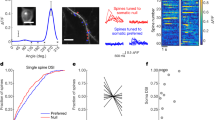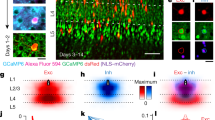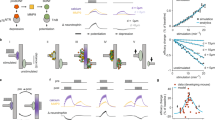Abstract
Direction selectivity (DS) of simple cells in the primary visual cortex was recently suggested to arise from short-term synaptic depression in thalamocortical afferents (Chance F, Nelson S, Abbott L (1998), J. Neuroscience 18(12): 4785–4799). In the model, two groups of afferents with spatially displaced receptive fields project through either depressing and non-depressing synapses onto the V1 cell. The degree of synaptic depression determines the temporal phase advance of the response to drifting gratings. We show that the spatial displacement and the appropriate degree of synaptic depression required for DS can develop within an unbiased input scenario by means of temporally asymmetric spike-timing dependent plasticity (STDP) which modifies both the synaptic strength and the degree of synaptic depression. Moving stimuli of random velocities and directions break any initial receptive field symmetry and produce DS. Frequency tuning curves and subthreshold membrane potentials akin to those measured for non-directional simple cells are thereby changed into those measured for directional cells. If STDP is such that down-regulation dominates up-regulation the overall synaptic strength adapts in a self-organizing way such that eventually the postsynaptic response for the non-preferred direction becomes subthreshold. To prevent unlearning of the acquired DS by randomly changing stimulus directions an additional learning threshold is necessary. To further protect the development of the simple cell properties against noise in the stimulus, asynchronous and irregular synaptic inputs are required.
Similar content being viewed by others
References
Adelson E, Bergen J (1985) Spatio-temporal energy models for the perception of motion. J. Opt. Soc. Am. A 2: 284–299.
Ahmed B, Anderson J, Douglas R, Martin K, Nelson J (1994) Polyneuronal innervation of spiny stellate neurons in cat visual cortex. J. Comp. Neurol. 341(1): 39–49.
Albus K, Wolf W (1984) Early post-natal development of neuronal function in the kitten's visual cortex:Alaminar analysis. J. Physiol. 348: 153–185.
Bi G, Poo M (1998) Synaptic modifications in cultured hippocampal neurons: Dependence on spike timing, synaptic strength, and postsynaptic cell type. J. Neuroscience 18(24): 10464–10472.
Bienenstock E, Cooper L, Munro P (1982) Theory for the development of neuron selectivity: Orientation specifity and binocular interaction in visual cortex. J. Neuroscience 2(1): 32–48.
Blais B, Cooper L, Shouval H (2000) Formation of direction selectivity in natural scene environments. Neural Computation 12(3): 1057–1066.
Borst A, Egelhaaf M (1989) Principles of visual motion detection. Trends in Neurosci. 12(8): 297–306.
Buchs N, Senn W(1999) Learning direction selectivity through adaptation of the probability of the vesicle release probability. In: Society for Neuroscience, Abstracts, No. 898.15.
Buchs N, Senn W (2001) Learning direction selectivity through spike-timing dependent modification of neurotransmitter release probability. Neurocomputing 38-40: 121–127.
Carandini M, Ferster D (2000) Membrane potential and firing rate in cat primary visual cortex. Journal of Neuroscience 20(1): 470–484.
Carandini M, Heeger D, Senn W (2001) Thalamocortical synaptic depression and the responsiveness of the primary visual cortex. Neuron, submitted.
Chance F, Nelson S, Abbott L (1998) Synaptic depression and the temporal response characteristics of V1 cells. J. Neuroscience 18(12): 4785–4799.
Cremieux J, Orban G, Duysens J, Amblard B (1987) Response properties of area 17 neurons in cats reared in stroboscobic illumination. J. Neuroscience 57: 1511–1535.
Djupsund K, Hayden B, Ham T, Dan Y (2001) Stimulus-timing dependent plasticity of intracortical connectivity in adult V1. In: Society for Neuroscience, Abstracts, No. 619.26.
Durand S, Freeman T, Mante V, Kiper D, Carandini M(2001) Crossorientation suppression in cat V1 with very fast stimuli. In: Society for Neuroscience, Abstracts.
Feidler J, Saul A, Murthy A, Humphrey A (1997) Hebbian learning and the development of direction selectivity: The role of geniculate response timing. Network: Computation in Neural Systems 8: 195–214.
Feldman D (2000) Timing-based LTP and LTD at vertical inputs to layer II/III pyramidal cells in rat barrel cortex. Neuron 27: 45–56.
Freeman T, Durand S, Kiper D, Carandini M (2001) Crossorientation suppression in V1 following cortical adaptation. In: Society for Neuroscience, Abstracts.
Fusi S, Annunziato M, Badoni D, Salamon A, Amit DJ (2000) Spikedriven synaptic plasticity: Theory, simulation, VLSI implementation. Neural Computation 12: 2227–2258.
Gao H, Fu Y-X, Shen K, Dan Y (2001) Spatial plasticity of receptive fields in the cat primary visual cortex. In: Society for Neuroscience, Abstracts, No. 821.62.
Geinisman Y, Berry R, Disterhoft J, Power J, Van der Zee E (2001) Associative learning elicits the formation of multiple-synapse boutons. J. Neuroscience 21(15): 5568–5573.
Hawken M, Shapley R, Grosof D (1996) Temporal-frequency selectivity in monkey visual cortex. Vis. Neurosci. 13: 477–492.
Heeger D (1993) Modeling simple-cell direction selectivity with normalized half-squared, linear operators. J. Neurophysiol. 70(5): 1885–1898.
Hubel D, Wiesel T (1962) Receptive fields, binocular interaction and functional architecture in the cat's visual cortex. J. Physiol. (London) 160: 106–154.
Hubel D, Wiesel T (1963) Receptive fields of cells in striate cortex of very young, visually inexperienced kittens. J. Neurophysiol. 26: 994–1001.
Humphrey A, Saul A (1998) Strobe rearing reduces direction selectivity in area 17 by altering spatiotemporal receptive-field structure. J. Neuroscience 80: 2991–3004.
Humphrey A, Saul A, Feidler J (1998) Strobe rearing prevents the convergence of inputs with different response timings onto area 17 simple cells. J. Neuroscience 80: 3005–3020.
Jagadeesh B, Wheat H, Ferster D (1993) Linearity of summation of synaptic potentials underlying direction selectivity in simple cells of the cat visual cortex. Science 262: 1901–1904.
Jagadeesh B, Wheat H, Kontsevich L, Ferster D (1997) Direction selectivity of synaptic potentials in simple cells of the cat visual cortex. J. Neurophysiol. 78: 2772–2789.
Kempter R, Gerstner W, van Hemmen J (1999) Spike-based compared to rate-based Hebbian learning. In: MS Kearns, SA Solla, DA Cohn, eds.,Advances in Neural Information Processing Systems, vol. 11, pp. 125–131.
Lendvai B, Stern E, Chen A, Svoboda K (2000) Experiencedependent plasticity of dendritic spines in the developing rat barrel cortex in vivo. Nature 404: 876–881.
Maex R, Orban G(1996) Model circuit of spiking neurons generating directional selectivity in simple cells. J. Neurophysiol. 75: 1515–1545.
Markram H, Lübke J, Frotscher M, Sakmann B (1997) Regulation of synaptic efficacy by concidence of postsynaptic APs and EPSPs. Science 275: 213–215.
Markram H, Pikus D, Gupta A, Tsodyks M (1998) Potential for multiple mechanisms, phenomena and algorithms for synaptic plasticity at single synapses. Neuropharmacology 37: 489–500.
Markram H, Tsodyks M (1996) Redistribution of synaptic effi-cacy between neocortical pyramidal neurons. Nature 382: 807–810.
Mehta M (2000) From hippocampus to V1: Effect of LTP on spatio-temporal dynamics of receptive fields. In: J Bower, ed., Trends in Neuroscience, Proceedings of the CNS'99. pp. 905–911.
Meister M, Lagnado L, Baylor D (1995) Concerted signaling by retinal ganglion cells. Science 270: 1207–1210.
Meister M, Wong R, Baylor D, Shatz C (1991) Synchronous bursts of action potentials in ganglion cells of the developing mammalian retina. Science 252(5008): 939–943.
Nagano T, Fujiwara M (1979) A neural network model for the development of direction selectivity in the visual cortex. Biol. Cybernetics 32(1): 1–8.
Ohzawa I, Sclar G, Freeman R (1985) Contrast gain control in the cat's visual system. J. Neurophysiol. 54: 651–667.
Orban G, Gulyas B, Spileers W, Maes H (1987) Responses of cat striate neurons to moving light and dark bars: Changes with excentricities. J. Opt. Soc. Am. A 4(8): 1653–1665.
Pasternak T, Schumer R, Grizzi M, Movshon J (1985) Abolition of visual cortical direction selectivity affects visual behavior in the cat. Exp. Brain Res. 61: 214–217.
Rao R, Sejnowski T (2000) Predictive sequence learning in recurrent neocortical networks. In: S Solla, T Leen, K-R Muller, ed., Advances in Neural Information Processing Systems 12. MIT Press, pp. 164–170.
Reid R, Soodak R, Shapley R (1987) Linear mechanisms of directional selectivity in simple cells of cat striate cortex. Proc. Natl. Acad. Sci. USA 84(23): 8740–8744.
Reid R, Soodak R, Shapley R (1991) Directional selectivity and spatiotemporal structure of receptive fields of simple cells in cat striate cortex. J. Neurophysiol. 66(2): 505–529.
Reid R, Victor J, Shapley R (1992) Broadband temporal stimuli decrease the integration time of neurons in cat striate cortex. Vis. Neurosci. 9: 39–45.
Saul A, Feidler J (2002) Development of response timing and direction selectivity in cat visual thalamus and cortex. J. Neuroscience 22: 2945–2955.
Saul A, Humphrey A (1992a) Evidence of input from lagged cells in the lateral geniculate nucleus to simple cells in cortical area 17 of the cat. J. Neurophysiol. 68: 1190–1208.
Saul A, Humphrey A (1992b) Temporal frequency tuning of direction selectivity in cat visual cortex. Vis. Neurosci. 8: 365–372.
Senn W, Buchs N (2002) Spike-based synaptic plasticity and the emergence of direction selective simple cells: Mathematical analysis. J. Computational Neuroscience 13: 167–185.
Senn W, Tsodyks M, Markram H (2001) An algorithm for modifying neurotransmitter release probability based on preand post-synaptic spike timing. Neural Computation 13(1): 35–68.
Shapley R (1996) Linearity and non-linearity in cortical receptive field. Ciba. Found. Symp. 184: 71–87.
Softky W, Koch C (1993) The highly irregular firing of cortical cells is inconsistent with temporal integration of random EPSPs. J. Neuroscience 13(1): 334–350.
Song S, Miller K, Abbott L (2000) Competitive hebbian learning through spike-timing dependent synaptic plasticity. Nature Neuroscience 3: 919–926.
Soodak R, Shapley R, Kaplan E (1991) Fine structure of receptive-field centers of X and Y cells of the cat. Vis. Neurosci. 6: 621–628.
Stratford K, Tarczy-Hornoch K, Martin K, Baninster N, Jack J (1996) Excitatory synaptic inputs to spiny stellate cells in cat visual cortex. Nature 382: 258–261.
Suarez H, Koch C, Douglas R (1995) Modeling direction selectivity of simple cells in striate visual cortex within the framework of the canonical microcircuit. J. Neuroscience 15(10): 6700–6719.
Sur M, Leamey C(2001) Development and plasticity of cortical areas and networks. Nat. Rev. Neuroscience 2: 251–262.
Tsodyks M, Markram H (1997) The neural code between neocortical pyramidal neurons depends on neurotransmitter release probability. Proc. Natl. Acad. Sci. USA 94: 719–723.
Watson A, Ahumada A (1985) Model of human visual-motion sensing. J. Opt. Soc. Am. A 2: 322–341.
Wimbauer S, Wenisch O, van Hemmen J, Miller K (1997) Development of spatiotemporal receptive fields of simple cells: II. Simulation and analysis. Biol. Cybernetics 77(6): 463–477.
Yao H, Dan Y(2001) Stimulus timing-dependent plasticity in cortical processing of orientation. Neuron 32: 315–323.
Zhang L, Tao H, Holt C, Harris W, Poo M (1998) A critical window in the cooperation and competition among developing retinotectal synapses. Nature 395: 37–44.
Author information
Authors and Affiliations
Rights and permissions
About this article
Cite this article
Buchs, N., Senn, W. Spike-Based Synaptic Plasticity and the Emergence of Direction Selective Simple Cells: Simulation Results. J Comput Neurosci 13, 167–186 (2002). https://doi.org/10.1023/A:1020210230751
Issue Date:
DOI: https://doi.org/10.1023/A:1020210230751




